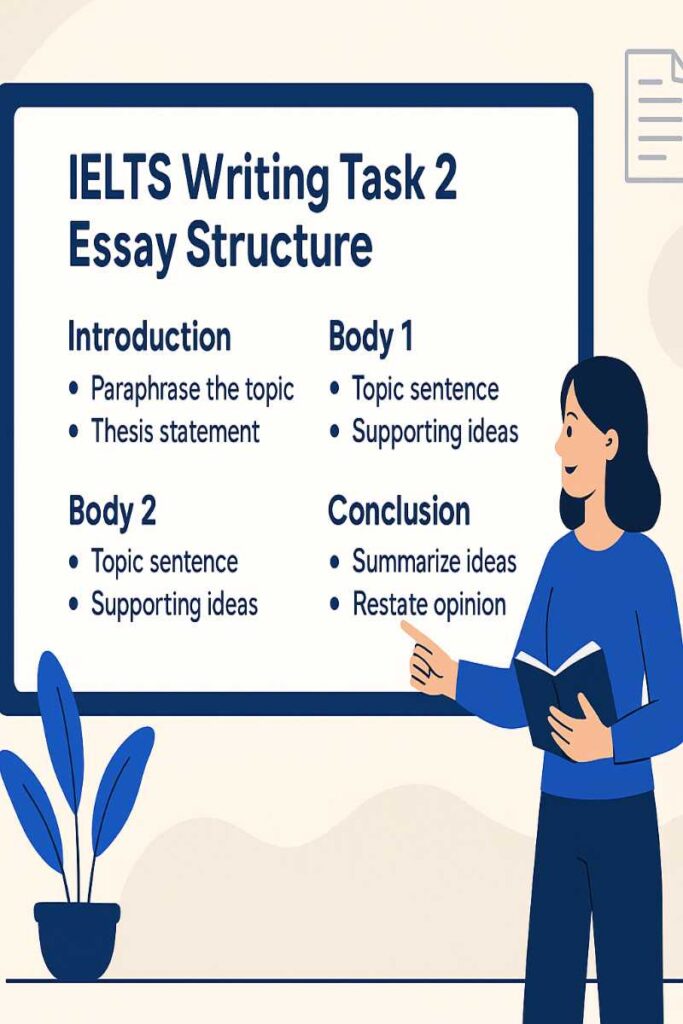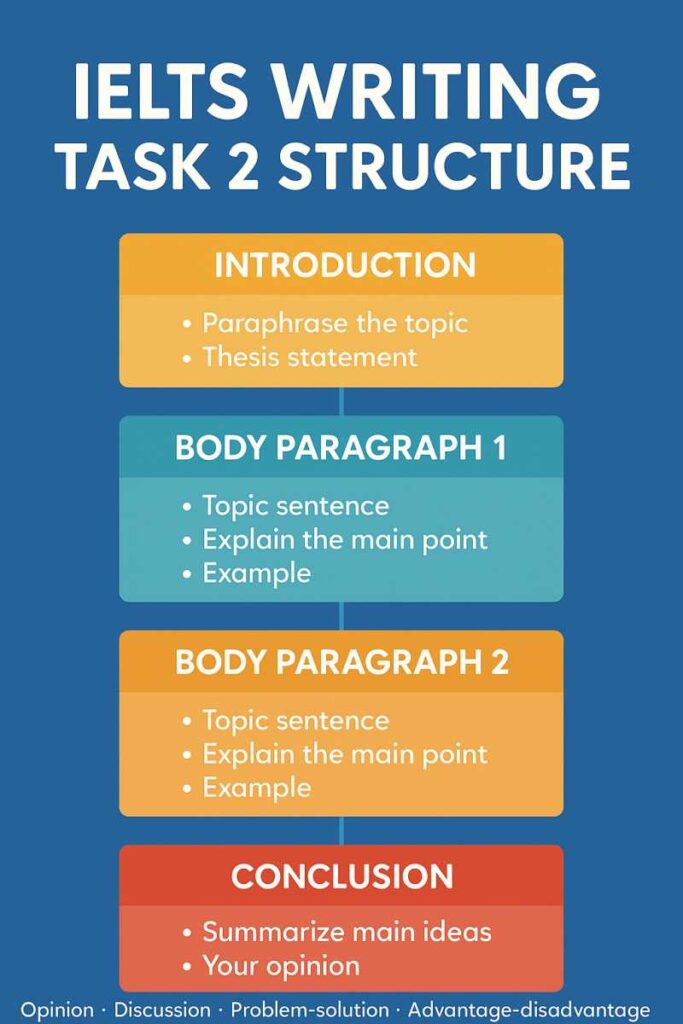To get a Band 8 and above on IELTS Writing Task 2, you need more than just a big vocabulary. Your essay also needs to be well-organised so that the examiner can easily follow your points. Coherence and cohesion are two of the four scoring factors. To do well in them, you need to be organised and make sure that your ideas make sense.
What you’ll learn in this piece is:
How to write each type of essay in the best way
Broken down paragraph by paragraph
Sentence models for beginnings, parts of speech, and endings
How to make your writing more cohesive and reasonable

– PEEL Method: How to Use the PEEL Method in IELTS Task 2 Body Paragraphs for Band 8+
Why Structure Is Important for Task 2 of the IELTS
Task 2 asks you to write an essay of at least 250 words in which you talk about a question or problem. Some types of essays are:
- Thought (Agree/Disagree)
- Talk (both points of view)
- Solution to a Problem
- Benefits and Drawbacks
- Two-part double question
A standard four-paragraph format makes sure that your writing is clear and well-organised, no matter what the topic is.
The Best Way to Structure an Essay (4–5 Paragraphs)
- Beginning (40–50 words)
- Body Part 1 (80 to 100 words)
- Body Part 2 (80 to 100 words)
- Body Paragraph 3 is optional, but most double-question essays use it
- The end (30–40 words)
Breaking Down Each Paragraph Step by Step

1. The Introduction’s Goal:
- What is the question again
- Say what you think or give an idea of what the essay will be about
Example:
There is more and more disagreement about [topic summarised]. There are people who believe [viewpoint A] and people who argue [viewpoint B]. This article will [make it clear what it is going to do or what you think].
Example of an opinion piece:
A lot of people think that to cut down on pollution, public travel should be free. I can see why this idea would be helpful, but I strongly think that it is not a good solution in all countries.
Tip: In the opening, do not give examples or explanations.
2. Body Paragraph 1’s Goal:
- Give your first main point of view or thought
- Give reasons and examples to back up what you say
Example:
That is one of the main reasons why [main idea] is important. As an example, [give a clear example or proof]. Because of this, [name the end or consequence].
Such as:
One great thing about free public transport is that it makes traffic less backed up. In places like Singapore, 20 percent fewer people drove their own cars after subsidised metro passes were put in place. Because of this, the air quality in cities got a lot better.
Tip: Each paragraph should have one clear idea that you should develop fully.
3. Body Paragraph 2 Goal:
- If it’s a conversation essay, give the second idea or the opposite point of view
- Give examples and what happened as a result
Example:
[Reason] is another reason why [second idea] is important. For example, [example]. That’s proof of that [analysis].
Example:
Making public travel free might not be good for business. Without fares, governments may find it hard to meet their operating costs. For example, in some European towns, these kinds of rules caused too many people to use the services and made them less good, which made people not want to use them.
Tip: Always connect your examples to the question of your writing.
4. Choose to Include Body Paragraph 3
If you want to:
- You are writing an essay with two questions
- Your points are strong, and each one should be talked about on its own
Template for a Double-Question:
Along with [first question], [second question] is also very important to think about. [Explain your point of view]. As an example, [give details].
5. Conclusion: Why
- Restate your main point of view or a brief summary of each side
- Do not add any new information
Example:
In the end, even though [opposing idea], I agree with [your stance]. This is why [suggestion if applicable] is important.
Example:
In conclusion, free public transport might help cut down on pollution, but it’s not realistic in many countries because it costs too much. Instead, governments should work on making things more affordable and efficient.
Tip: Keep away from words like “In my opinion, I think that” that are used too much.
Differences in Structure by Type of Essay
| Type of Essay | Introduction | Parts of the Body | In Conclusion |
| Thought (Agree/Disagree) | Rewrite + Give Your Opinion | Two paragraphs to back up your point of view | Restate your opinion |
| Talk (Both Points of View) | Rewrite + Both Points | Two points of view each get one paragraph | Make your point of view clear |
| Solution to a Problem | Outline and Paraphrase | 1) Describe the situation; 2) Suggest ways to fix it | Write a short summary of both the pros and cons |
| Benefits and Drawbacks | Outline and Paraphrase | 1) Pros and Cons; 2) Balance | Summary or opinion that is fair |
| Two Questions | Rephrase and Ask Both | 1) Give an answer to question 1; 2) Give an answer to question 2 | Write down replies or take a stand |
Using Words to Connect Things
Use these to make clear links between and within lines of ideas:
Beginning:
A lot of people think that…
More and more people are worried about…
A lot of people say that…
Adding Thoughts:
In addition
Besides that
Even more
Giving Examples:
As an example
For example
Like
Different Thoughts:
But
In any case
What Happens and Why:
In the end
Since then
Because of this
Final Thoughts:
To sum up
Briefly
General
Tip: Don’t use linking words too much; only use them when needed.
Common Mistakes in Structure to Avoid
- Not including an overview or conclusion → There should be a good beginning and end to every essay
- Too many ideas in one sentence → In each line, stick to one idea and build on it
- Putting in personal thoughts or stories in Task 1 → Only Task 2 needs personal views
- Reusing words or ideas → Use different words and phrases for each point
- Structure that is too hard to understand → Don’t use long or hard-to-understand sentence structures just to sound smart
Example of an Essay Plan (Opinion Essay)
Question:
Some people believe that raising the price of petrol is the best way to make traffic less bad. How much do you agree or disagree?
Plan for the Essay:
Introduction
- Rewrite the subject
- Say what you think (disagree)
Body Sentence 1
- People who are poor are hurt more by high fuel prices
- Countries that price fuel still have traffic jams
Body Sentence 2
- Better idea: Put money into public transport
- For example, Seoul’s train system cut down on traffic by 30 percent
Conclusion
- Say what you disagree with
- Provide a better option
How to Get Better at Putting Together Essays
- Read sample Band 9 writings from Cambridge books and look at how the paragraphs are put together
- Before writing full essays, make outlines and work on the framework first
- To keep the flow of your writing reasonable, use sentence starters or templates
- Plan five articles a week but don’t write them all yet
- You can look at sample writings on IELTS Liz, IELTS Simon, and IELTS Advantage
Checklist for Essay Structure Before Turning In
- The theory and paraphrase are in the introduction
- There is one idea and evidence in each body paragraph
- Smooth transitions and clear topic lines
- Conclusion sums up main points of view or ideas
- There should be no repeats or details that aren’t related to the theme
- A formal tone and a range of language
A Work to Do for Practice
Pick one of the questions below and write a planned four-paragraph outline for it.
Question:
There are people who think that kids should learn how to handle money in school. Should I agree or not
Plan:
Foreword: Rephrase and opinion
Body 1: Why learning about money is important
Body 2: The present curriculum doesn’t prepare students for the real world
Conclusion: I strongly agree with and recommend
Thoughts for Now
Your essays can go from average to Band 8 and above if you learn how to organise them for IELTS Writing Task 2. An organised essay helps the reviewer follow your reasoning, enjoy your writing, and give you points for how well you use language.
Remember: simple is better than complicated. Pay attention to organisation, coherence, and relevance, and do it often.
Call to Action
Which type of IELTS essay is the hardest for you – an opinion, a conversation, or a problem-solution essay
Leave a comment below, and we’ll help you out by making a thorough guide
Sign up to get weekly writing prompts, forms, and sample answers

About the AuthorWelcome to TechIELTS. I’m Md. Jahangir Alam, an experienced engineer with over 15 years in electrical and automation systems. Alongside my engineering career, I’ve developed a strong interest in English language learning and IELTS preparation.
I hold a Duolingo English Test score of 135 (IELTS 7.5 equivalent) and am currently pursuing an M.Sc. in Cyber Security from Royal Holloway, University of London. I use my technical background to create clear, structured IELTS learning materials for students and professionals.
👉 Connect on LinkedIn
